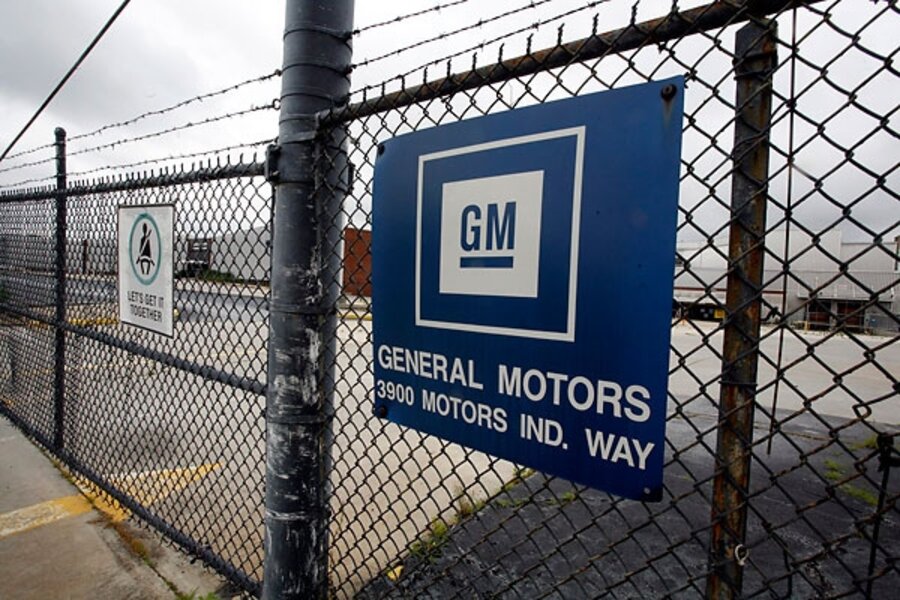GM deal eases path through bankruptcy
Loading...
By breaking an impasse with creditors, the US Treasury showed it is pushing to make the mammoth restructuring of General Motors as smooth as possible for the automaker and the economy.
GM still appears headed for bankruptcy, with the government providing cash and a guiding hand. But the Treasury reached an accord Thursday with key investors who hold the company’s bonds. The new offer of a 10 to 15 percent stake in GM is not a huge windfall for the bondholders, but it’s enough to reduce the prospects of lengthy litigation during bankruptcy.
By giving up a little more to bondholders, the Treasury and GM have a better shot at achieving an important objective: a speedy bankruptcy that preserves as much of the firm’s economic value as possible.
That could be good news for all involved, including not just workers and investors but also the general public. US taxpayers are on the hook to help General Motors get back on its feet. The better GM does, the less costly the rescue will be for taxpayers in the end.
By contrast, a slow and messy bankruptcy could hurt both the company and the national economy -- potentially causing wider job losses in the auto industry and boosting the taxpayer tab.
A committee representing some of GM’s largest bondholders announced its support for the compromise Thursday, citing the risks of litigation as an important reason.
“When contrasted with the alternative -- uncertain and costly bankruptcy court litigation -- it represents the best alternative for bondholders in the current difficult and dire situation,” the committee said in a statement. “Rejecting this offer [and litigating] was a risk the Committee is unwilling to take.”
GM still has a wide range of creditors who won’t necessarily sign onto the government-supported restructuring plan. And other legal issues are certain to arise during the bankruptcy process, which is expected to begin on Monday.
But support for the plan from these core creditors represents a major step toward a smooth bankruptcy, analysts say.
The deal underscores the high stakes for the Obama administration, as it seeks to end a recession and revive one of America's most prominent industries.
Efforts to save GM have become an intricate exercise involving company executives, union workers and retirees, bondholders, and a White House task force that is advising President Obama and the Treasury. Bankruptcy is a last resort, but industry experts say the competing interests and GM's complexity point toward the need for courtroom approval of the restructuring.
Documents made public by GM and the creditors Thursday provide a tentative roadmap for a GM overhaul:
• GM would sell its key assets such as factories to a "New GM," purchased largely by the Treasury. The goal is for New GM to emerge quickly as a potentially profitable company.
• A remaining firm, "Old GM," would remain in court for creditors to seek to recover what they can as the assets are sold. This "old" and "new" split is similar to what another Detroit carmaker, Chrysler, is seeking to do in its own bankruptcy this month (also with Treasury assistance).
• Bondholders, who had rejected an earlier offer of a 10 percent stake in the New GM, will now get that plus warrants to purchase another 15 percent of the new firm.
• The New GM would be owned 72.5 percent by the Treasury, representing an infusion of some $40 billion from taxpayers. Meanwhile, GM would reduce its debts dramatically by "debt for equity" swaps with creditors. That includes the 10 percent stake for bondholders, plus a 17.5 percent stake for a trust that finances healthcare for GM's union retirees.
• The new firm would have debt of $17 billion, with nearly half of that owed to the Treasury. It would also owe 9 percent annual dividends on $9 billion in preferred stock -- with some shares owned by the Treasury and some by the union healthcare trust.
The government has given a deadline for bondholders to sign on to the plan, since many have not yet decided whether to support it. The Treasury says that unless a satisfactory number express support by Saturday at 5 p.m., “the amount of common equity and warrants [for bondholders] would be substantially reduced or eliminated.”





